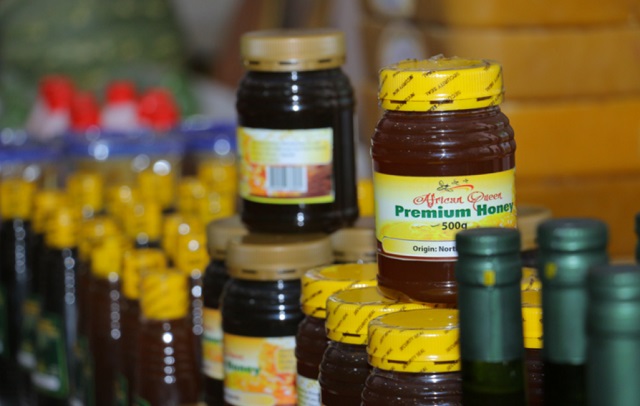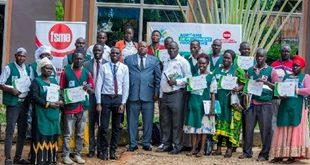
More research and policy guidance needed to improve value chain for non-wood forest products
Kampala, Uganda | RONALD MUSOKE | Honey, beeswax and shea butter are some of the non-wood forest products with a lot of potential of contributing to nutrition, food security, household incomes and forest conservation in the West Nile region in northwestern Uganda.
But lack of equipment and training, wildfires, distance to markets, poor market information, sub-standard harvesting techniques, and a decline in bee forage due to landscape degradation are slowing progress, according to a project jointly implemented by the UN’s Food and Agriculture Organization (FAO) and the World Agroforestry Centre (ICRAF-Uganda).
Non-wood forest products consist of goods other than wood derived from forests. These include; mushrooms, fruits, nuts, herbs, aromatic plants, game, fibres (used in construction, clothing or handicrafts), resins, gums, saps and products used for medical cosmetic or cultural scopes.
Other non-wood forest products that were found to have value chains that can be developed include balanites oil and the edible grasshopper popularly known as Ese in West Nile and Nsenene in central Uganda.
Erik Acanakwo, a scientist attached to the World Agroforestry Centre noted that despite the potential value of non-wood forest products in West Nile, these products are not receiving much attention while the influx of refugees and competing land uses continue to cause degradation of landscapes, affecting their availability.
Apiary experts say bee keeping has particularly been cited as an example of a profitable conservation industry. But it must reach its full economic potential or there will not be a strong enough incentive for people to protect trees.
Bee keepers need a lot of trees for forage which by implication means more food for the bees. This results in richer honey harvests, providing a financial incentive for maintaining the forests or even reforestation where landscapes have been damaged.
The researchers consulted over 200 wild product gatherers in Yumbe, Arua and Moyo districts during the assessment. From the findings, honey, beeswax, shea butter as well as grasshoppers were found to have the greatest potential in the region. The West Nile region is, for instance, the largest honey producing zone in Uganda with close to 85,000kg of honey produced annually.
The value chain for bee products in the region is characterized by several dealers including; beekeepers (90%) and honey collectors (10%). However, these are largely unorganized, poorly equipped mostly with traditional hives. The chain also has processors (60%) and traders (40%).
Beekeepers supply honey to local processors who transform and sell the product at local markets with a kilogramme selling at Shs16, 000-18,000. On the other hand a kilogramme of beeswax costs between Shs 25,000-30,000.
Dr. Clement Okia, the World Agroforestry Representative for Uganda told The Independent that traditionally, Ugandans have only cared about honey yet beeswax is one of the most lucrative bee products on the international market.
Acanakwo noted that honey sampled from West Nile contains significant amount of total polyphenol and vitamin C contents that can support immune system functions. He said there is high demand for honey for food/medicine; however, production is below potential. The deficit is augmented with imports from Sudan and the Democratic Republic of the Congo.
He noted that residue analysis in honey had however showed presence of pyrrolizidine alkaloids which can be toxic. He attributed this to contamination with smoke, dung and other
debris.
Issa Katwesige, the principal forest officer at the Forest Sector Support Department in the Ministry of Water and Environment said the timing for the project is right but noted that the major challenge of ensuring that these products become commercially viable is the rapid land use change that is taking place around the country.
“The natural belt for some of these species is mainly in the rangelands which are vulnerable to fires, industrialization and human settlement,” he said.
Dr. Antonio Querido, the FAO Representative for Uganda told The Independent that the project is meant to help people understand that by conserving forests, they can get more than just chopping wood.
More research needed
Going forward, Querido said more research and policy guidance are required to improve the value chain for non-wood forest products, especially those with high market potential. He said FAO will continue to raise awareness among different sectors including; forestry, health, and education about the important contribution these goods can contribute to people’s livelihoods.
Querido said evidence gathered in recent years shows that forests, trees and wild and semiwild foods can contribute to resilient lives and livelihoods.
But, Phillip Nyeko from the Department of Forestry, Biodiversity and Tourism at Makerere University said Uganda needs to prioritize nonwood forest products that can be developed based on demand and the target market.
****
 The Independent Uganda: You get the Truth we Pay the Price
The Independent Uganda: You get the Truth we Pay the Price


